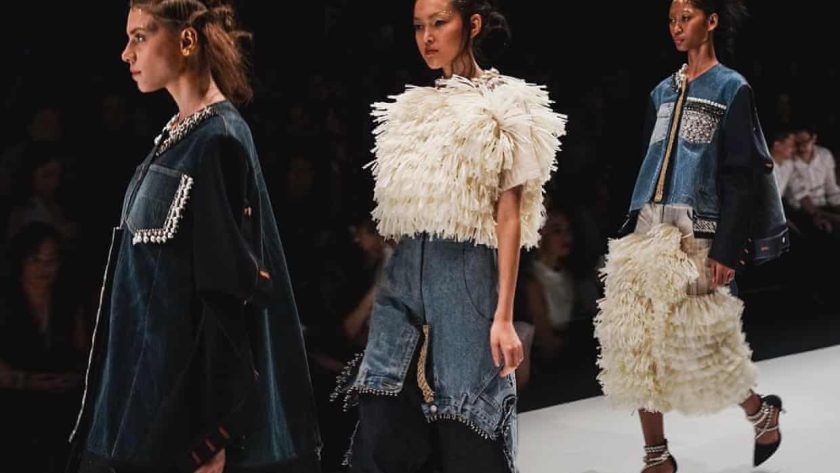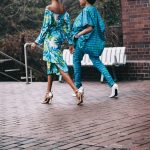Fashion Open Studio has recruited nine leading designers to host a series online workshops on everything from upcycling to education to commemorate the United Nations Climate Change Conference
Can the fashion industry actually reduce its impact on the environment? Nine innovative designers representing five continents are proving that it is possible. They have created a number of solutions for some of the problems facing their communities.
Fashion Open Studio, a British Council initiative, asked designers to address the themes of climate change and adaptability for a series online workshops. If you happen to be in Glasgow between November 4 to 11, you can take part in workshop events around the city, or to watch previous events and find out about upcoming workshops online, check out .fashionopenstudio.com/events. Here are the names you need to know:
BORA STUDIO, NEPAL

Bora Studio, a slow-fashion and environmentally responsible clothing brand, was founded in Nepal by Meena Gurung. Bora is a Nepalese word that refers to a jute bag. Gurung reuses these bags to create the collections. Jute sacks can be used for multiple purposes, from planting seeds in the fields to harvesting and selling the produce. Every Nepali household has a jute bag in their home. Gurung says, “I wanted my clothing as a medium for people to adapt sustainability and to be nature-friendly.”
Gurung has been working for the past three years with local communities in Nepal to develop natural dyeing awareness and make sustainable choices as individuals. Bora Studio recently worked with an ethnic community from Koshi Tappu Sunsari, Eastern Nepal. They are known as “Sardar”, and live in the Koshi Tappu wetland. A noxious invasive species, water hyacinth, is threatening the river ecosystems and taking over local lands. The women were taught how to harness water from the hyacinth and weave matts, bags, and curtains. Because it is rich in nitrogen, you can use it to fertilize their fields.
SINDISO KHUMALO (SOUTH AFRICA)

Sindiso Khumalo, a textile designer, is based in Cape Town. Khumalo studied architecture at University of Cape Town. She worked in London for Sir David Adjaye before she completed her MA at Central Saint Martins Textile Futures.
Khumalo was inspired by her mother who was an activist against apartheid, and she has worked hard to incorporate social justice values into her brand, which she launched in 2014. Khumalo is interested in black women’s portraits from the 1920s to the 1980s. Each garment tells a story of Africa, women, and female empowerment.
Her collections are based on textiles and crafts. She works closely with NGO’s and has small workshops in South Africa, Burkina Faso and South Africa that produce unique hand-woven and hand-embroidered textiles. Ignite Dignity, a Cape Town-based NGO that works to rehabilitate those who were trafficked or found themselves in exploitative situations, employs her. Burkina Faso is also home to a workshop that produces handwoven cloth using hemp, recycled and organic yarns and upcycled materials. They have increased their production from 40 metres in order six years ago to over 1,000 meters this year.
GARCIA BELLO ARGENTINA

Garcia Bello was created in Tierra del Fuego, Argentina by Juliana Garcia Bello (a FADU graduate in Clothing Designer). It is a brand that focuses on upcycling and reconstruction. The brand uses recycled materials, donated clothes, and old, discarded clothes to create its locally-produced collections. The pattern design incorporates two types of zero-waste patterns. This allows them to make use of secondhand clothes and makes the most of the cloth.
They describe the brand as having a slow pace and a limited stock. Every piece is genderless, and the size can be adapted to different body types. They can create durable, comfortable and timeless garments that will last a lifetime. Bello describes her method as “human-scale production”. Bello enjoys sharing her methods and inviting others to try them.
RAHEMUR RAHMAN BANGLADESH

Rahemur Rahman’s fashion brand redefines what it means to have fashion “made in Bangladesh”. London-born Bangladeshi Rahman, a Bangladeshi-born designer, uses design, print, and weave to reinterpret South Asian stories. He plays with texture and patterns to create unique pieces for people who love colour. Since graduating from Central Saint Martins, the designer has developed a unique style of designing. He only works with natural fibers and textiles that have been naturally dyed using a traditional wooden block technique from Bangladesh, called Wax and Resist dye. This allows him to focus on the “death” of each garment and consider how it will decompose after it has been disposed of. These natural elements will take between 10 and 20 years to completely decompose, becoming earth again for a new lease on life. Every garment manufactured by the brand contains a tiny seed inside that will allow for a tree’s growth wherever it has “death”.
Rahman wants to connect with the community where he grew-up through social engagement projects. Rahman, who works with Aranya Crafts Council in Bangladesh and the World Fair Trade Organisation, creates sustainable, ethically produced textiles using the traditional technique for natural dye. This allows Rahman to bring textiles from the subcontinent into an international audience.
The brand draws inspiration from textiles found in museums in the UK that date back to pre-colonial West Bengal. It is committed to working with young people from marginalized backgrounds to create galleries and exhibitions throughout the UK in order to address the engagement gap in these communities at these prestigious institutions of art.
TOTON, INDONESIA

Toton, a Jakarta-based brand, was founded by Haryo Balitar and Toton Januar, a Parsons New School graduate. It draws on Indonesia’s rich culture and heritage and works with local artisans to preserve traditional techniques and reduce environmental damage from big factories and the irresponsible waste of chemicals.
The brand began to use repurposed denim in 2017 to create a collection entirely from materials they had at home. It started working with pre-consumer waste and denim from small to medium Jakarta factories. Because of the limited amount of waste material, the brand is able to explore more sustainable production and aesthetic methods. Toton has been using only waste materials in its denim pieces since then. The average monthly denim waste use is around 150 m3 – 200 m3 per month. Although it is still a small amount, we are working to increase it organically. “We want pieces that last and not another product that will soon be going to landfill.”
VIMBAI NATASHA NAOMI ZIMBABWE
Vimbai Mupfurutsa founded the Zimbabwean brand Vimbai Natasha. Vimbai Mupfurutsa founded Vimbai Natasha Naomi, a Zimbabwean brand that uses upcycling, innovation, and experimentation. The brand also makes careful use of discarded, sampled, and pre-loved clothing. Mupfurutsa uses rescued fabric from a nearby cotton mill that was recently closed to make fabric. Mupfurutsa hopes to promote sustainable fashion from the mills to the consumers by rescuing old textiles. She also wants to encourage upcycling and encourage people to buy second-hand clothing. She works with women from poor backgrounds and communities to teach them how to repurpose fabric.
She says that pollution is the main contributor to the current titanic climate change. Unfortunately, the people most directly affected by it are not. Consumption is a dominant feature of developed countries. This is where people buy excessive quantities and then discard them in ways that are harmful to the environment. This lifestyle encourages unsustainable fast fashion practices, such as labour exploitation and unfair trade, as well as the misuse of the earth’s natural resource. Mupfurutsa sees herself as a role-model to help inspire slower, more sustainable consumption and discourage the practice incinerating stock and samples. As a designer, I believe that mobilizing resources for my local community will make a long-lasting positive impact on social sustainability.
IRO IRO INDIA

Bhaavya Goenka started her label IRO IRO with a question. Why was fashion, which is organic and natural, so polluting the environment? She created a business using hand-woven fabrics that are made from recycled textiles. They are woven by skilled weavers in a village near Jaipur. Each IRO IRO product is a revival of a dying craft tradition. Every one sold supports a family weavers to allow them to pursue a passion.
Goenka has been a specialist in the upcycling and reuse of textile waste using indigenous Indian craft techniques. This has allowed her to spread a new circular production system. Iro Iro works with other businesses to recycle their waste into textiles that can be used in fashion and interiors. This creates work for 20 artisans who are based in a village close Jaipur. Goenka says, “Our constant motivation to reimagine fashion’s system and not limit our innovation to the product” “We aim to create fashion that shares in its losses, but not its profits,” says Goenka.
THAILAND, BHUKRAM

Bhukram, a Thai fashion brand that Pilan Thaisuang founded, uses clothes to tell stories about the Phu Phan communities way of living and their natural environment. The embroidery art shows the connections between community members, outsiders, and people and nature. To work with the Ban Nang Toeng Village in Sakon Nakhon Province, Thailand, the brand employs a participatory community process.
The design team is responsible for all aspects of each collection. This includes the silhouettes, fabrics and subjects that will be embroidered. After this, they coordinate with an array of artisans, including the embroiderers, who are the main storytellers. They share their stories to increase awareness about environmental protection and preserve the traditional way of living. Bhukram’s subtle colours reflect the natural world of Phu Phan and the traditional way of living.
Thaisuang says that the current mainstream fashion industry is destroying traditional agriculture, craft, and cultural diversity. “Bhukram allows small-scale zero mile production, regional fiber systems, and creation of local and sustained jobs for communities,” says Thaisuang. With co-design, participatory practices and many important decisions being made locally by artisans directly involved, “much of the decision-making and know-how, cultural and economic value, and the ability to make them, remains in the hands and pockets of the local community.”
HUNER, TURKEY

Huner, an Istanbul-based accessory brand, repurposes old sails to make durable bags and accessories. The base material for sail cloth is made of carbon fiber and plastic coating. However, they transform this material into bags that can last many times more than its original form. Sails lose their performance after a few uses.
Huner Aldemir says, “Our main goal, without having anything produced for us, is to produce.” She founded her limited-batch brand in 2017. Huner Aldemir, who grew up sewing from scrap fabrics at her aunt’s house, was adamant about her primary goal. After receiving her BFA degree in Fashion Design at Pratt Institute, Brooklyn, NY, she apprenticed with Peter Som in New York. After graduating from Pratt Institute in Brooklyn, NY, she worked as a fashion designer at several e-commerce sites in Istanbul. She was uneasy about the high levels of production and mass consumption. We believe that reducing our environmental impact is the best way to reduce our carbon footprint. Aldemir says Huner is an upcycling brand. Aldemir says that there is so much material out there, waiting to be used into useful products. It seems reckless to increase the production of virgin goods. There are other ways to produce our goods, and we have the ability to alter our thinking and do so in order change our current course.





